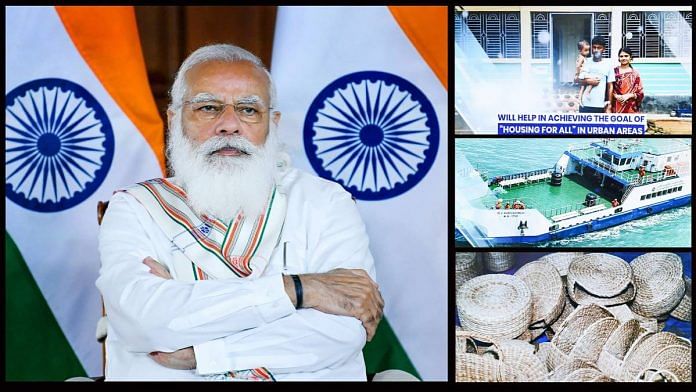New Delhi: The Ministry of External Affairs (MEA) has commissioned an expansive study to map existing connectivity projects in the country’s Northeast region and India’s development assistance projects in neighbourhood countries Nepal, Bhutan, Bangladesh and Myanmar, ThePrint has learnt.
Once completed, the study would enable the government to “identify how existing investments in India and outside India can be linked and leveraged to create a regional transport network”, a top official told ThePrint on condition of anonymity.
The North Eastern Development Finance Corporation Ltd (NEDFi), a government-run public financial institution, will carry out the study.
According to a second official, India now has a much greater focus on connectivity projects in the country’s Northeast and the neighbouring regions.
This is keeping in mind the country’s larger security interests, especially with the Chinese threat under President Xi Jinping’s ‘Belt and Road Initiative’ looming large over the neighbouring countries of Nepal, Bhutan, Bangladesh and Myanmar, the official said.
Under the Modi government, connectivity projects have become an integral part of India’s foreign policy, especially when it comes to the ‘Act East Policy’ as well as ‘Neighbourhood First Policy’.
Sources said the study is being conducted with “an eye on China” and the strengthening of a larger role being played by India in the northeastern states.
Also read: India, Russia, China need to ensure aid reaches Afghan people without hindrance: Jaishankar
Ongoing projects and new initiatives
Some of India’s key projects in the Northeast — also involving the neighbouring countries — include the Kaladan Multi-modal Transit Transport Project, the India-Myanmar-Thailand Trilateral Highway Project, and the Rhi-Tiddim Road Project. These have been ongoing for over a decade and are aimed at connecting India to Southeast Asia via Myanmar and Bangladesh.
Earlier this year, India also vowed to give a massive push to enhance infrastructure connectivity with Bangladesh.
In March, PM Modi and Bangladesh Prime Minister Sheikh Hasina virtually inaugurated the ‘Maitri Setu’, which allows the landlocked Northeast easy access to the Chittagong Port.
Beyond these projects, India is planning or executing several other proposals that are aimed at strengthening the country’s relationship with the neighbourhood.
While addressing the Indian Chamber of Commerce last, Foreign Secretary Harsh V. Shringla referred to the study as he noted the value of connectivity projects in India’s Northeast and beyond.
“We have also commissioned a study by the North Eastern Development Finance Corporation that will ‘map’ connectivity projects in northeastern India and Indian-supported connectivity projects in countries neighbouring this region. The idea is to identify synergies and possible growth corridors,” Shringla said.
India is also taking a number of public diplomacy initiatives in order to keep the focus on eastern and Northeast India intact.
“We have tried to increase our engagement with such stakeholders and partners through a number of public diplomacy initiatives,” Shringla said.
According to Shringla, the Ministry of External Affairs (MEA) is supporting a number of new Track 1.5 and Track 2 dialogues and conferences with a focus on enhancing India’s public diplomacy that will prove to be an added advantage in pushing the projects ahead.
Recent initiatives included a BIMSTEC-focused dialogue in Kolkata, a Kolkata-Dhaka Dialogue that brings together think tanks and academic institutions in India and Bangladesh; a ‘Nadi’ conference in Shillong that focuses on cooperation within the region, and a Kanchenjunga Dialogue based in north Bengal and Sikkim that has a BBIN (Bangladesh, Bhutan, India and Nepal)-focus, the foreign secretary said.
Also read: China lodges protest with India over CDS Gen Bipin Rawat’s comments on ‘security threat’
‘India doing well in NE connectivity projects’
Rajiv Bhatia, a veteran diplomat and distinguished fellow at the think tank Gateway House, said the study may have been triggered by the fact that not many people are aware about the progress that India is making in developing a number of infrastructure connectivity projects in the Northeast.
“Due to lack of knowledge and understanding, we only tend to flag the mega projects and bring embarrassment to the country. Hence, such a study mapping the projects in that part of the country was highly needed. Contrary to popular perception, we have done a lot and achieved a lot in terms of connectivity in that region,” he added.
Lack of connectivity in this region has led to abysmal growth in trade. For instance, India’s land-based trade with Myanmar, across a 1,500km-long border in the Northeast region, is about the same as the country’s total trade with distant Nicaragua in Central America, according to a study — India’s New Approach to Regional Connectivity — by the Centre for Social and Economic Progress (CSEP).
“The first and most important driver of the new connectivity policy is a geostrategic response to China and its unprecedented linkages across the subcontinent. Breaking into what was India’s sphere of influence, Beijing has massively expanded its diplomatic, economic, and political footprint across South Asia,” the CSEP study said.
According to the study, in terms of infrastructure, over a dozen new Integrated Check Posts are being constructed or expanded to facilitate trade and mobility along the borders with Nepal, Bangladesh, Bhutan, and Myanmar.
Bhatia added that the projects in the Northeast will get further impetus when the BIMSTEC Summit takes place in 2022, which is expected to witness the unveiling of a masterplan for connectivity.
(Edited by Amit Upadhyaya)
Also read: ‘Bringing bilateral issues to SCO violates norms, offenders must be condemned:’ Jaishankar






